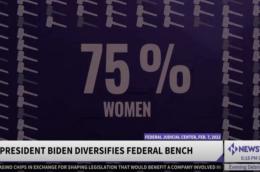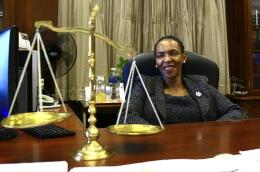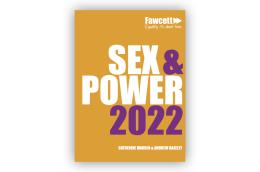The question has never been whether women can lead as capably as men. Women have always led, and women will always lead, especially when the times are hard, and their communities are in need.
The question that we need to ask is, why is women’s leadership invisible? Why is their potential and their power stifled?
In the midst of a global pandemic, we find women on the front lines everywhere, as heads of government, legislators, healthcare workers, community leaders, and more. Although women’s organizations and community groups shoulder much of the responsibility of preventing the spread of the virus and serving those in greatest need, they are perennially left out of decision-making processes.
Today, women are Heads of State and Government in only 21 countries, despite the strong case that their leadership makes for more inclusive decision-making and more representative governance, even during this pandemic. Men are still 75 per cent of parliamentarians and hold 73 per cent of managerial positions. Most negotiators in formal peace processes are also men.
This year, International Day of Democracy comes as a reminder that unlocking the full breadth of perspectives, experiences and leadership of women is vital for building back better from this pandemic.
How women lead for the wellbeing of all, in just five stories that you may have missed.
1. Demonstrating strong women’s leadership in the pandemic
[[{"fid":"17760","view_mode":"media_original","fields":{"format":"media_original","field_file_image_alt_text[und][0][value]":false,"field_file_image_title_text[und][0][value]":"Her Excellency Vjosa Osmani is a Doctor of Legal Sciences, former professor and mother of two girls. Photo: Office of the Assembly President "},"link_text":null,"type":"media","field_deltas":{"1":{"format":"media_original","field_file_image_alt_text[und][0][value]":false,"field_file_image_title_text[und][0][value]":"Her Excellency Vjosa Osmani is a Doctor of Legal Sciences, former professor and mother of two girls. Photo: Office of the Assembly President "}},"attributes":{"title":"Her Excellency Vjosa Osmani is a Doctor of Legal Sciences, former professor and mother of two girls. Photo: Office of the Assembly President ","class":"media-element file-media-original","data-delta":"1"}}]]
From Germany to New Zealand and Denmark to Iceland, women leaders have shown clarity, empathy, and strong communication in their decisions and policies during the COVID-19 pandemic. Vjosa Osmanu, the first woman assembly president in Kosovo, is among the many women leaders praised for their leadership during the crisis.
A former professor and mother of two girls, Osmanu is an outspoken advocate for women’s representation in politics. “When women participate in high-ranking political and state level [positions], they contribute to more balanced, gender-sensitive, environmentally considerate and forward-looking policies,” she says.
During the pandemic, women in Kosovo have faced high levels of vulnerability. Like many countries, Kosovo has seen a rise in domestic violence cases since lockdown measures were introduced. “I am consistently raising my voice about the pandemic’s gender dimensions, sharing relevant facts and information, while closely monitoring all government actions,” says Osmani.
Working to protect vulnerable populations from threats related to the COVID-19 crisis, she has joined the UN Women Kosovo campaign against domestic violence and has worked closely with UNICEF on issues related to children’s health and families’ wellbeing.
“A limited number of women hold leadership positions globally and the same applies to Kosovo. Social productivity cannot be reached while people are marginalized, discriminated and face gender-based barriers,” she shares, adding that both men and women need to contribute to efforts that put more women in decision-making positions.
2. Fighting food insecurity on the front lines
[[{"fid":"17761","view_mode":"media_original","fields":{"format":"media_original","field_file_image_alt_text[und][0][value]":false,"field_file_image_title_text[und][0][value]":"Women at Peace Village in Jetis, Central Java. Women’s groups' members have been taking central roles as community volunteers in stepping up to stop the spread of COVID-19. Photo courtesy of Wahid Foundation."},"link_text":null,"type":"media","field_deltas":{"2":{"format":"media_original","field_file_image_alt_text[und][0][value]":false,"field_file_image_title_text[und][0][value]":"Women at Peace Village in Jetis, Central Java. Women’s groups' members have been taking central roles as community volunteers in stepping up to stop the spread of COVID-19. Photo courtesy of Wahid Foundation."}},"attributes":{"title":"Women at Peace Village in Jetis, Central Java. Women’s groups' members have been taking central roles as community volunteers in stepping up to stop the spread of COVID-19. Photo courtesy of Wahid Foundation.","class":"media-element file-media-original","data-delta":"2"}}]]
Democratic principles are at the heart of the GUYUB project, an initiative providing essential support to women in Indonesia during the COVID-19 crisis. Guyub in Indonesian means “getting along” or “in togetherness”. It’s a philosophy that connects communities even as physical distancing and lockdown measures have disrupted social lives.
Jointly implemented by UN Women, UNODC and UNDP, the project provided recently distributed food and hygiene packages to families in ten Peace Villages across Java. Upon arriving in the villages, the packages were distributed by a women-led task force, in partnership with the Indonesian NGO Wahid Foundation.
“Large-scale social restrictions that were imposed in our city created a challenge for us… to buy, prepare and distribute food packages and hygiene kits,” says Siti Yulaikha, Task Force Member from Sidomulyo, Batu City, East Java. However, the women leaders made use of a facility that had previously served as a food bank, and although movement was limited, they managed to distribute the packages to community members most in need.
“The residents are thankful for the food packages as many shops and markets are closed. They also used the hygiene kits, such as disinfectant and soap, not only at home, but at public spaces, such as the village security post,” says Yulaikha.
To protect the health of their villages, task force members took up other important virus prevention roles as well, disinfecting public spaces, producing and distributing masks, and spreading awareness about health protocols. They have also set up a centre for coronavirus data collection, contact tracing, and health checks.
Their agile adaptation to the challenging circumstances doesn’t stop there; when many women saw dips in earnings due to closed markets and lost business opportunities, they recalled learnings from prior entrepreneurship training and created a WhatsApp group to serve as an online marketplace.
“Food stall owners utilized WhatsApp to arrange takeaway food orders and home delivery. These efforts have helped them with vital, sustained income during the pandemic,” Yulaikha says.
3. Leading virus prevention efforts across Libya
[[{"fid":"17765","view_mode":"media_original","fields":{"format":"media_original","field_file_image_alt_text[und][0][value]":false,"field_file_image_title_text[und][0][value]":"Women peacebuilders are using their mobile phones to support COVID-19 response efforts in Libya. Photos: Courtesy of Libyan Women’s Network for Peacebuilding."},"link_text":null,"type":"media","field_deltas":{"4":{"format":"media_original","field_file_image_alt_text[und][0][value]":false,"field_file_image_title_text[und][0][value]":"Women peacebuilders are using their mobile phones to support COVID-19 response efforts in Libya. Photos: Courtesy of Libyan Women’s Network for Peacebuilding."}},"attributes":{"title":"Women peacebuilders are using their mobile phones to support COVID-19 response efforts in Libya. Photos: Courtesy of Libyan Women’s Network for Peacebuilding.","class":"media-element file-media-original","data-delta":"4"}}]]A step ahead of much of the working world, the 36 women involved in the Libyan Women’s Network for Peacebuilding were accustomed to connecting via phones and computers well before the pandemic hit. Separated by their country’s divisions, the women leaders who come from diverse social, generational, and geographic backgrounds, have been communicating over WhatsApp and Zoom since July 2019 to discuss peacebuilding strategies.
“We believe that we should be one Libya,” says a member of the Network, created with support from UN Women. The members are experienced activists; each is linked to her own regional network of activists that work to support their community. When the threat of the pandemic became known, the women quickly adapted their online activism to respond to the situation.
They shared vital information about the virus and how it spreads on national and local radios, provided cleaning and sanitizing products to low-income households, and disseminated gender-based violence hotline numbers. They partnered with other organizations to distribute masks and gloves in prisons and detention centres and called for the release of prisoners who are either on a short sentence or near to completing their sentence, particularly those who are elderly or ill.
Because the network of women spans the country, they have valuable insights into regional needs and have been instrumental in highlighting population-specific humanitarian issues.
Despite their vital role in managing conflicts and making peace in families and communities, Libyan women are rarely allowed to enter male-dominated decision-making and negotiation spaces. Fighting against multiple issues at once – coronavirus threats as well as marginalization of women in peace processes – these women leaders continue to push for a safer, healthier, more peaceful Libya.
“Libyan women are at the forefront of response to problems; from COVID 19 to the horrific consequences of a conflict that has divided their country and inflicted unimaginable suffering on their communities,” says Begoña Lasagabaster, UN Women Representative in Libya. “It is high time that they had their rightful place in peace talks and their say on the future of Libya.”
4. Breaking down barriers to health services and information for indigenous communities
[[{"fid":"17766","view_mode":"media_original","fields":{"format":"media_original","field_file_image_alt_text[und][0][value]":false,"field_file_image_title_text[und][0][value]":"Waleska López Canú. Photo Courtesy Waleska López Canú"},"link_text":null,"type":"media","field_deltas":{"5":{"format":"media_original","field_file_image_alt_text[und][0][value]":false,"field_file_image_title_text[und][0][value]":"Waleska López Canú. Photo Courtesy Waleska López Canú"}},"attributes":{"title":"Waleska López Canú. Photo Courtesy Waleska López Canú","class":"media-element file-media-original","data-delta":"5"}}]]
Dr. Waleska López Canú, Medical Director of Wuqu’ Kawoq or Maya Health Alliance, is proud to be Maya Kaqchikel. Her indigenous identity informs much of the work she does with Maya Health Alliance which provides medical services in the most impoverished communities in Guatemala.
Since the onset of the pandemic, López has coordinated telemedicine treatment for severe and chronic malnutrition, sexual and reproductive health, and complex and chronic illnesses so that patients can continue receiving life-saving care despite lockdown measures. Maya Health Alliance has also distributed food aid to more than 900 families.
In addition to providing treatment and aid, the organization seeks to reduce barriers to healthcare so that it can be accessed by all. In the ongoing fight against COVID-19, López has witnessed how language can be a barrier to communicating about virus prevention in indigenous communities. To better serve these marginalized groups, Maya Health Alliance, together with associated institutions, has created a series of videos, audios, and radio programmes, tailored to rural and indigenous contexts, to be distributed in seven Mayan languages, as well as Spanish.
With López as Medical Director, Maya Health Alliance has taken on several other vital roles in COVID-19 response: the organization facilitates the sharing of prevention measures among health professionals through a WhatsApp group of more than 180 members from more than 100 community-based organizations. They also provide personal protective equipment to students in their last year of medical school who offer services in the rural areas, and online assessment and training to medical professionals.
“The crisis caused by the pandemic has made visual our harsh reality, which has historically been neglected,” says López. “Indigenous women, little by little, are becoming conscious of our true role in the family and in society. We have much to contribute, from our life experiences and the knowledge of who we are and [what] we want, as well as the knowledge of the real needs of the community itself.”
Read more about López and other women leaders here, in a collection of stories by the Inter-American Task Force on Women’s Leadership. UN Women is a member of the Task Force, a body composed of key inter-American and international institutions working to promote and support women's leadership in the Americas and the Caribbean.
5. Preventing the spread of COVID-19 in refugee settlements in Uganda
[[{"fid":"17767","view_mode":"media_original","fields":{"format":"media_original","field_file_image_alt_text[und][0][value]":false,"field_file_image_title_text[und][0][value]":"Martha Achok raises awareness on how to prevent the spread of COVID-19 in Uganda. Photo: UN Women /Aidah Nanyonjo"},"link_text":null,"type":"media","field_deltas":{"6":{"format":"media_original","field_file_image_alt_text[und][0][value]":false,"field_file_image_title_text[und][0][value]":"Martha Achok raises awareness on how to prevent the spread of COVID-19 in Uganda. Photo: UN Women /Aidah Nanyonjo"}},"attributes":{"title":"Martha Achok raises awareness on how to prevent the spread of COVID-19 in Uganda. Photo: UN Women /Aidah Nanyonjo","class":"media-element file-media-original","data-delta":"6"}}]]In the Bidibidi settlement for refugees and displaced persons in the Yumbe District of Uganda, Joyce Maka waits at the water collection point. The mother of three is a refugee from Sudan, arriving in Uganda after her husband was killed by rebels, and she is one of 12 women peace mediators in Zone B of the settlement now leading the fight against COVID-19.
Maka waits at the water station because, despite lockdown measures, people (usually women and girls) still need to frequent this spot in order to collect their water, making it a strategic point to pass on life-saving information. Since the onset of the pandemic, disseminating information about the virus has been challenging as most are confined to their homes.
“We encourage them to stay at least two metres away from each other; we also encourage them to wash their hands before and after pumping water,” Maka explains. In their role as peace mediators, Maka and others typically mediate community disputes, including issues of domestic violence, early marriage, and land rights. However, when the pandemic hit, the mediators transitioned to leading COVID-19 prevention measures.
The women have learned the importance of hand washing, physical distancing, wearing masks, testing, and quarantining, and they share this information with the wider community, through songs that they’ve composed in local dialect.
Gaining the trust and cooperation of the community is key to preventing the spread of COVID-19, so it’s important that the health information come from trusted community members, like the mediators. Their leadership and commitment to the wellbeing of all has never been more crucial.
Source: UN Women.





